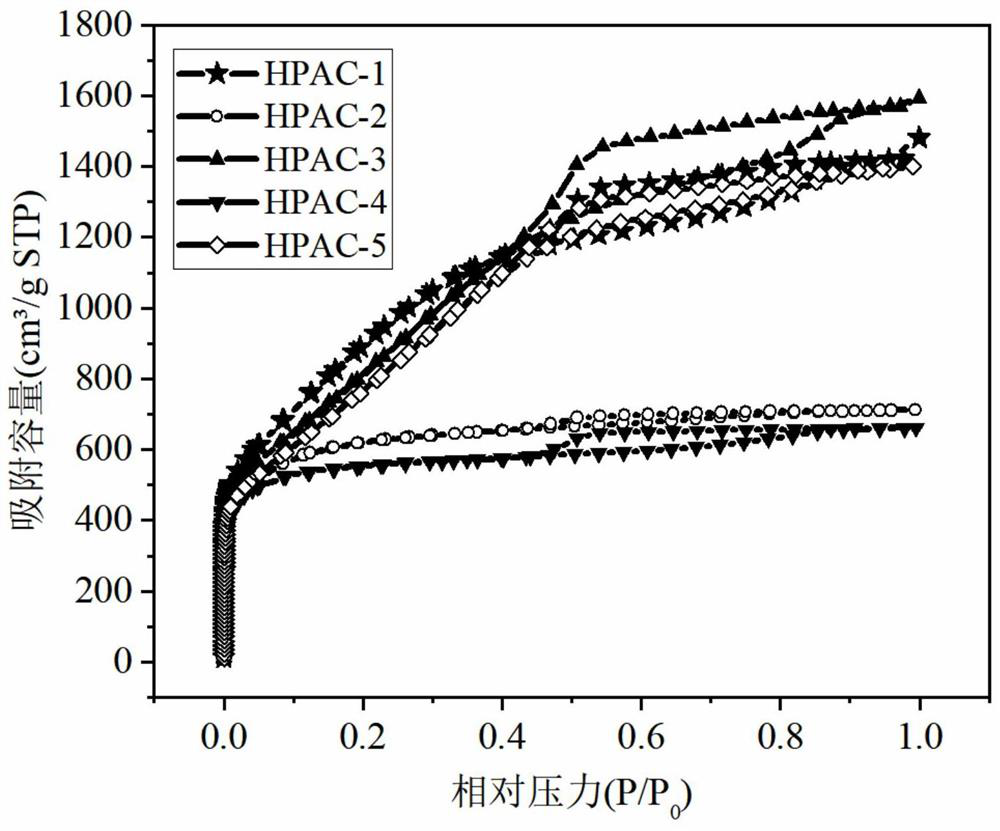High-specific-surface-area hierarchical-pore hollow carbon microspheres taking lignin as raw material and preparation method of microspheres
A high specific surface area, lignin technology, applied in chemical instruments and methods, carbon compounds, non-metallic elements, etc., can solve problems such as single pore size distribution, achieve simple operation, achieve high-value utilization, and achieve sustainable development. Effect
- Summary
- Abstract
- Description
- Claims
- Application Information
AI Technical Summary
Problems solved by technology
Method used
Image
Examples
Embodiment 1
[0041]In the first step, the coniferous alkali lignin and sodium sulfite are mixed according to a mass ratio of 5:1 and added to water, then stirred and reacted at 120°C for 6 hours, and then the pH of the aqueous solution is adjusted to 7.0 by carbon dioxide gas and sodium sulfite. The total solid content of coniferous alkali lignin and sodium sulfite in the solution is 30%, and finally the aqueous solution is placed in a centrifugal spray dryer for drying. The air inlet temperature of the spray drying is 250°C, and the air outlet temperature The temperature is 100°C, and the evaporation of water per hour is 1.5 tons; lignin microspheres can be obtained, and the moisture content of the lignin microspheres is less than 6%.
[0042] In the second step, the obtained lignin carbon microspheres are placed in a tube furnace and argon is introduced at a flow rate of 200ml / min, and then the temperature is raised to 450°C at a rate of 5°C / min, kept for 50min, and then naturally cooled ...
Embodiment 2
[0047] Mix coniferous alkali lignin and sodium sulfite at a mass ratio of 3:1 and add to water, then stir and react at 150°C for 4 hours, then adjust the pH of the aqueous solution to 8.0 with carbon dioxide gas and sodium sulfite, and inject The total solid content of the leaf material alkali lignin and sodium sulfite is 32%, and finally the aqueous solution is placed in a centrifugal spray dryer for drying. The air inlet temperature of the spray drying is 300°C, and the air outlet temperature is 120°C. The evaporation of water per hour is 2 tons, and the lignin microspheres can be obtained, and the moisture content of the lignin microspheres is less than 6%; Argon gas was introduced at a flow rate of 8°C / min, and then raised to 400°C at a rate of 8°C / min, kept for 60 minutes, and then naturally cooled to room temperature to obtain carbonized lignin microspheres; the carbonized lignin microspheres were mixed with potassium hydroxide according to After blending at a mass ratio...
Embodiment 3
[0050] Mix coniferous alkali lignin and sodium sulfite at a mass ratio of 1:1 and add to water, then stir and react at 220°C for 2 hours, then adjust the pH of the aqueous solution to 9 with carbon dioxide gas and sodium sulfite, and inject The total solid content of the leaf alkali lignin and sodium sulfite is 36%, and finally the aqueous solution is placed in a centrifugal spray dryer for drying. The air inlet temperature of the spray drying is 300°C, and the air outlet temperature is 120°C. The evaporation of water per hour is 2 tons, and the lignin microspheres can be obtained, and the moisture content of the lignin microspheres is less than 6%; The flow rate of argon was passed into, and then the temperature was raised to 500°C at a rate of 10°C / min, and kept for 80 minutes, and then naturally cooled to room temperature to obtain carbonized lignin microspheres; the obtained carbonized lignin microspheres were mixed with potassium hydroxide according to After blending with...
PUM
| Property | Measurement | Unit |
|---|---|---|
| diameter | aaaaa | aaaaa |
Abstract
Description
Claims
Application Information
 Login to View More
Login to View More - R&D
- Intellectual Property
- Life Sciences
- Materials
- Tech Scout
- Unparalleled Data Quality
- Higher Quality Content
- 60% Fewer Hallucinations
Browse by: Latest US Patents, China's latest patents, Technical Efficacy Thesaurus, Application Domain, Technology Topic, Popular Technical Reports.
© 2025 PatSnap. All rights reserved.Legal|Privacy policy|Modern Slavery Act Transparency Statement|Sitemap|About US| Contact US: help@patsnap.com



